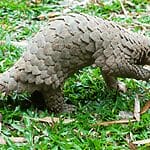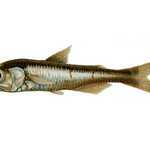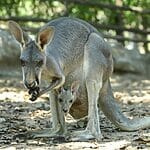When it comes to birth in the animal kingdom, males usually don’t play a direct role in delivering offspring. However, a select group of male animals stands out for doing the unexpected—they actually give birth. This unusual phenomenon raises questions about nature’s diverse approaches to reproduction and why evolution took this route for some species.
One notable example is the seahorse, where males carry the fertilized eggs in a specialized pouch, nurturing them until they’re ready to emerge. This process involves physical strain and hormonal changes, much like female pregnancy in other animals.
In this guide, we’ll dive into how and why these unique males take on such a critical role in reproduction. We’ll explore what makes these species distinct, uncover their fascinating birth processes, and answer questions about how they endure the challenges that come with this rare responsibility.
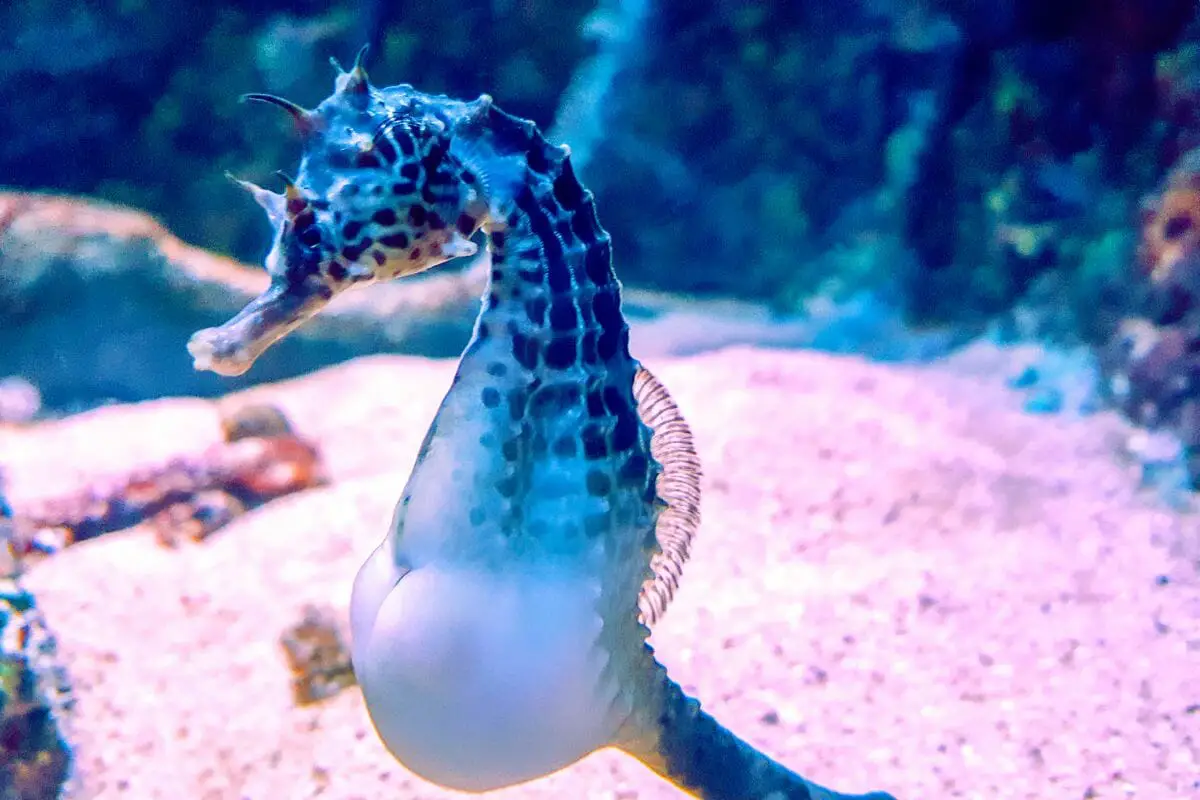
Anatomy Of Male Fish That Give Birth
This group of fish are fascinating. They have the ability to share the responsibility of child-bearing. Initially, the female will lay her eggs. When this happens, she will transfer her eggs to the male.
In seahorses, the male will have a pouch that is specialized to store the eggs. In pipefish and sea dragons, the eggs are attached to their tails to keep them safe.
After this, the male then fertilizes the egg. The male will carry the eggs for the entire duration of the period of incubation. The males are responsible for ensuring that the eggs have everything they need in terms of nutrients and immunity.
These creatures have long snouts and rigid bodies – features that make these marine animals giving birth even more remarkable. They don’t have a pelvic fin, instead relying on their dorsal fins to move them around. This makes them very slow fish.
Seahorses, pipefish and sea dragons, marine creatures found in tropical seas and oceans across the world, get pregnant and give birth depending on the species.
Seahorses
Seahorses are one of the few animals where males are responsible for carrying the young. Seahorses are commonly depicted on TV and in films, specifically shown in Disney films such as The Little Mermaid.
Of all the male animals that get pregnant and give birth to their young, seahorses do this in the most advanced manner.
Male seahorses have a pouch on their tails that is designed to carry their young. The female lays the eggs and can transfer up to 1,500 eggs to the male.
The male will then fertilize these eggs and the fertilized eggs will then attach themselves to the inside of the male’s pouch.
While they are in the pouch, these eggs are protected and the male provides the eggs with everything that they need to develop. The gestation period will last anywhere between 9 and 45 days, and the babies will then begin to hatch.
When the eggs have hatched, the male will push the young out of their pouch. The male seahorse giving birth is an amazing occurrence, facilitated using strong muscular contractions.
Survival rate for these babies is very low, with less than 1 percent of these hatchlings surviving. Seahorses give birth to very large clutches for this reason, and the male will reproduce again just days later.
Pipefish
Another fish in this family where the males give birth are pipefish. These fish are pipe-shaped and long which is where they get their name.
They have many similarities to the seahorse as they are from the same family. These animals look like stretched seahorses.
Pipefish, one of the unique male animals that give birth, are very tiny creatures, only growing to around 14 inches long.
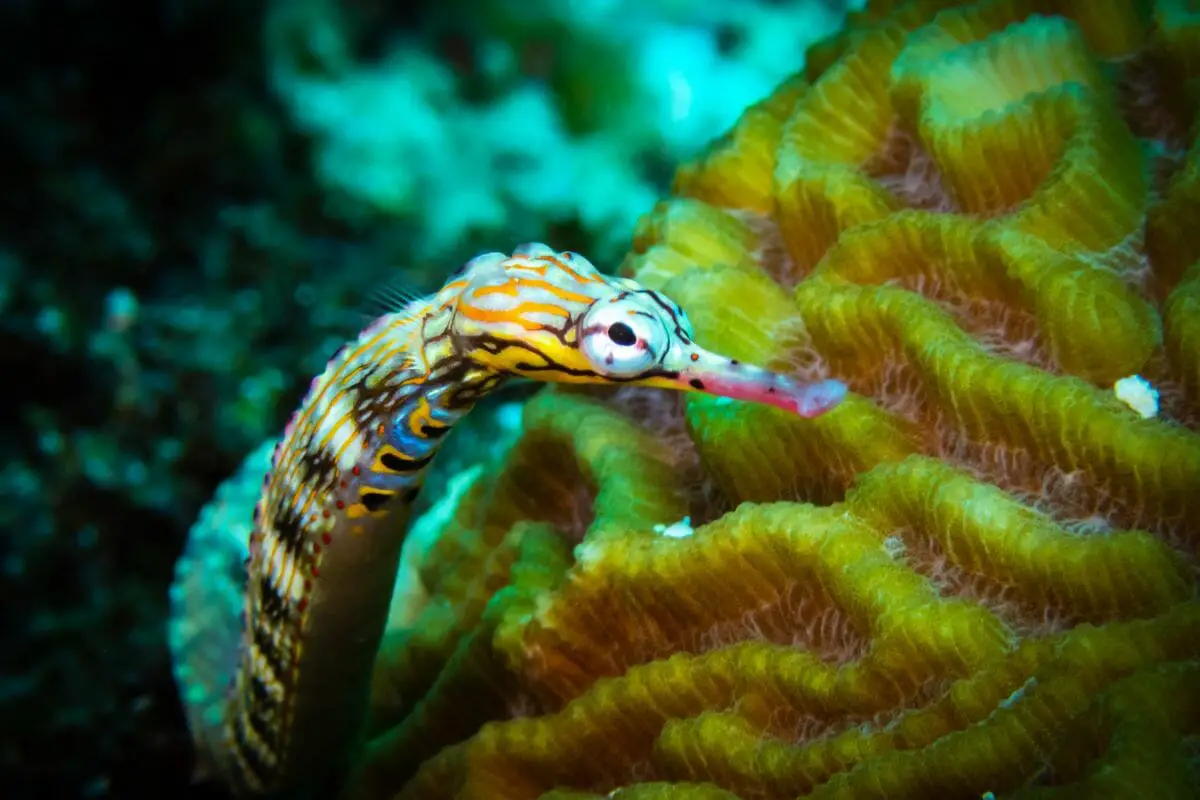
Some species of pipefish have a pouch, whereas other species simply attach the eggs to their tail. When the female lays her eggs, she will transfer these eggs to the male during mating. These eggs will be deposited in the pouch or tail.
Mating between pipefish is a very interesting thing to watch. They will wiggle and shake when they are mating, and when the eggs are deposited, they will float upwards together.
The male is then required to care for the offspring. This incredible process requires abundant energy from the male seahorse to fulfill fertilization, often consuming a lot of his nutrients.
Because pregnancy can be a challenging task for the male, they often resort to cannibalizing their offspring, providing them the necessary nutrients to remain strong.
Eating their young is a fairly common occurrence in the fish world, and it is known as filial cannibalism.
Sea Dragons

The incredible miracle of male pregnancy is also seen in sea dragons, creatures very closely related to seahorses. These marine creatures, able to get pregnant and give birth, are uncommon and are only found in the warm waters surrounding Australia.
There are three species of sea dragon, and the leafy sea dragon is the most well known. This fish has fins that look like leaves in order to help them to blend in with their surroundings.
Male sea dragons are responsible for carrying their young. Unlike seahorses carrying their offspring in a pouch, some species carry their offspring on their tail, an interesting approach to male animal pregnancy.
On their tail, there is a brood patch which provides everything that the offspring will need during their incubation period.
The female will deposit up to 250 eggs into this patch, and the male will then fertilize these eggs. The males will then carry the young for up to three months, depending on the specific species.
After the eggs hatch, they will often feed on the leftover embryos which are rich in nutrients. When these run out, they will have to find their own food.
Are The Young Independent From Birth?

While the males in the Syngnathidae family take care of their young during their incubation period, feeding them with nutrients and boosting their immunity for months at a time, these offspring are independent of the moment that they are born.
These animals are very vulnerable as they are very small when they are born. Less than 1 percent of seahorse offspring actually survive to adulthood.
When the baby seahorses are born, they are completely self-sufficient. It is up to them to escape their prey and survive.
If the babies do not leave, then the parents will actually eat their own offspring so it is important for the seahorses to go off on their own from the beginning.
Are Seahorses Endangered?
There is no doubt that male seahorses are trying their best to ensure that their offspring survive and thrive. However, after the fish are born, there is no parental support given to them.
These tiny marine creatures are very vulnerable, which is why a lot of seahorses get lost after birth.
However, lots of fish fertilize their eggs and there is no protection during the incubation period. In this way, seahorses do have a fairly high survival rate in comparison to other fish.
However, there are a lot of threats that this incredible creature, the seahorse, faces. Lots of these threats are caused by humans. There is a common occurrence of illegal trade happening where dried seahorses are sold for medicinal purposes or as souvenirs.
Seahorses are also often caught in the nets of shrimp fisheries and they are often caught to be sold in aquariums.
Facts About Seahorses And Their Relatives
- Seahorses don’t have a stomach! They have to eat between 30 and 50 times a day because food passes through them very rapidly
- Seahorses have a crown on their heads. This is called a coronet and it is distinct for each seahorse, similarly to a fingerprint
- Male seahorses can give birth to up to 2000 babies at one time
Why Do The Males Carry The Young In These Animals?

The exact reason why the males carry the young in these animals is not completely clear, however there are lots of theories as to why.
One of the reasons is that seahorse babies are very vulnerable and they often don’t survive after they are born as they are eaten by prey.
If the male gives birth to the baby, during the time that the male is pregnant, the female is able to create more eggs to be fertilized. This means that more babies are able to be born, meaning more will survive.
This implies that the males carry the young in order to sustain the population of these animals.
What Challenges Do These Species Face?
Birth-giving males, such as seahorses, pipefish, and sea dragons, encounter unique challenges across various aspects of their environment. Habitat degradation, climate change, and reproductive limitations each create obstacles that hinder these species’ survival and reproductive success.
To begin with, habitat degradation poses a significant threat. Many birth-giving males inhabit sensitive ecosystems like seagrass beds, mangroves, and coral reefs. These areas are highly vulnerable to human activities such as coastal development, which destroys essential habitats, limiting the availability of safe and suitable areas for breeding and feeding.
Pollution further exacerbates this issue, with chemical pollutants, agricultural runoff, and sedimentation degrading these environments and making them less hospitable.
Climate change also presents considerable difficulties for birth-giving males. Rising ocean temperatures and increased acidity directly impact seahorse physiology and behavior. While adult seahorses might tolerate some degree of warming, the combined effects of temperature rise and acidification often lead to lethargy and decreased feeding rates.
Additionally, sea-level rise threatens shallow-water habitats, reducing the availability of areas where these species thrive and reproduce.
Finally, reproductive challenges further complicate the survival of birth-giving males. Species like seahorses exhibit low reproductive rates, with smaller brood sizes compared to other fish.
These creatures are often monogamous, meaning that the loss of a partner can dramatically impact their ability to reproduce. Without a reliable mate, birth-giving males struggle to maintain population levels, making them more vulnerable to environmental pressures.
Is It Painful For Seahorses To Give Birth?
It seems to take a large toll on the male seahorse’s body to give birth. He uses a lot of his own nutrients while he is taking care of the eggs.
He also uses a lot of oxygen at this time. During the incubation period, the male seahorse is not able to do very much at all, and this can last up to 45 days. This is because he is using all of his energy to provide for the eggs.
The sight of a male seahorse giving birth is incredible, he uses muscular contractions to push the babies out. These are painful in the same way that they are for mammals.
After he gives birth, the male seahorse is left to recover. This takes several days, and the seahorse is unable to eat during this time.
FAQs
Why do male seahorses give birth instead of females?
Male seahorses give birth to allow females to produce more eggs while males incubate the current batch. This division of labor increases reproductive efficiency and enhances the survival chances of their offspring.
How do male seahorses carry their young?
Male seahorses have a specialized pouch where females deposit their eggs. The male fertilizes the eggs inside the pouch, providing nutrients and protection until the young are ready to hatch.
How do pipefish males care for their offspring?
Male pipefish may carry eggs in a pouch or attached to their tails, depending on the species. They fertilize the eggs and provide necessary nutrients until the young hatch and become independent.
Final Thoughts
There are only 3 fish where the male gives birth to the offspring. These are all relatives from the same family. The seahorse, pipefish and sea dragon all reproduce in this way.
There are no other known animal species in the animal kingdom in which the male is responsible for birthing the young making this very unique!
Reproduction takes on multifaceted forms in every species, where the female deposits eggs inside the male’s pouch, granting him the chance to nurture offspring. Evolution has sculpted ingenious mechanisms, from prehensile bellies to bony structures, facilitating the male’s unique reproductive role.
In this dance of life on Earth, observation reveals males changing color, showcasing courtship dances, and providing oxygen to their developing young in their uterus-like destinations.
Amidst the predation and challenges of their habitats, these males mature into providers of parental care, defying conventional roles.
Their existence paints a compelling narrative of adaptation and survival, reminding us of the intricate tapestry of life inhabiting our planet. Male animals bearing offspring stand as remarkable testaments to the resilience and wonder of the natural world.
- What Should I Do If A Koala Bites Me? Safety Guide - 2024-05-30
- Are Kangaroos Born Without Hind Legs? A Fascinating Journey - 2024-05-30
- Animals That Look Like Squirrels - 2024-05-30

